12 November 2002
Brenda Wortley and Maserame Tshwaedi
Acknowledgment
Thank you to the industry players who have contributed to developing this paper as well as those from the "outside" whose input has been invaluable in ensuring that the essence of the paper can be understood by a broader audience than those directly involved in the communications industry.
Executive Summary
-
This paper attempts to give a "helicopter view" of the marketing process, the external factors, and the various roles the players take in influencing targeting decisions. These key areas include: -
- the value chain
- return on investment,
- the economic climate in South Africa,
- measurement of communication elements,
- consumer needs and wants,
-
segmentation models. Here we expand and go into more detail particularly on the SAARF LSMs and discuss their application for today's communication environment.
- We conclude this paper by highlighting some of the marketing and advertising industries shortcomings as well as provide recommendations to move the transformation process forward.
-
In essence, it is the responsibility of marketers to drive the transformation process within their organisations and demand it of their agencies. However the entire Communication Value Chain from Marketer, Agency and Media owner need to embrace the transformation process in our new democracy.
- Finally ongoing training is critical. No person in our industries should ever stand still and "ride" on a historical knowledge base; our society is dynamic and we must always stay abreast of change.
Introduction
We welcome this opportunity to provide some insight into the strategic approaches used within the communication industry. We have attempted to take an open approach and highlight areas where we believe we could slip into unfair discriminatory practices. The currency of our industry is an intangible "thing" called brand equity. There is no absolute science or ready-made formula in how to make a brand successful and to build equity. Yet, we consider ourselves "professionals", and we attempt to bring the country's best strategic, analytical and creative minds together with the single focus of building brands.
Almost 10 years after the end of the apartheid era we cannot deny that racism still exists in society and we, the communications industry, cannot be exempt. Historically, the liberal use of the words "Whites and Blacks" has led to stereotyping and generalizations that crept into marketing speak.
We do not support racist practices in any way and would like to eradicate them completely from all our activities. We would therefore welcome further input from broader society to help fast-track the transformation process within our industry.
We recognize that we are an influential community with less than 5,000 people having the power to shape the behaviour of 43 million, and in light of this we acknowledge that we have a responsibility to respect individuals human rights and dignity as well as to embrace the country's transformation process.
This discussion should be seen as part of a broader change that is required in our industry, particularly around ownership, staffing and procurement. This process began looking at the "output" of communications, namely what consumers see and the advertising revenues that media owners receive. This has been too narrow and as such an understanding of the multi-faceted process that culminates in this end result will be presented.
The discussion is unfortunately limited to Above-the-Line (ATL) spend only, (such as traditional commercials flighted on television). We do not know enough about the huge Below-the-Line (BTL) or non-traditional spending (such as face to face communication, sampling etc), that could be the same size as traditional ATL advertising investment. However industry initiatives have begun to gain a better understanding of the size and nature of BTL investment.
Assumptions made
-
There are different ways of segmenting the market and these approaches are universal to marketing practices around the world. The approaches thus have little to no material impact on the variables we are seeking to examine.
- It is in the application and interpretation of research and tools that bias can come into play. To address unfair discrimination, the industry should focus on these areas.
Hypothesis
There is discrimination in decision making in the marketing and advertising industries, whether intentionally or unintentionally. This discrimination leads to biased/unequal marketing spend against certain segments and media vehicles.
Proposed definition of unfair discrimination within communications
With particular reference to our industry, unfair discrimination is where intentionally or unintentionally, the communication efforts of a brand alienate certain sectors or limit people's access to information. In both of these instances peoples' life chances and choices could be limited.
Setting the Marketing Stage
The Value Chain
In order to understand the marketing process and chain of decision making it is important to understand the various roles that marketers, creative and media agencies have in directing communication decisions. Clients (marketers), besides being at the start of the value chain, also have the largest sphere of influence - throughout the communication development process. The media agencies operate at the lower end and by and large dominate the interface with media owners. Media owners can influence strategic decisions up the value chain through innovative and strategically appropriate selling opportunities.
The following charts detail the decision making process in communication development and show the sphere of influence the various players.
The Marketers Sphere of Influence
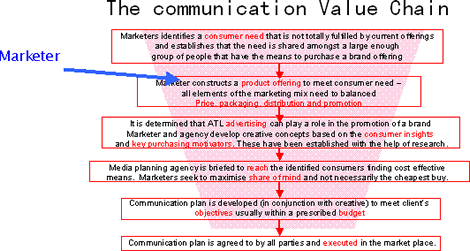
The Creative Agency Sphere of Influence
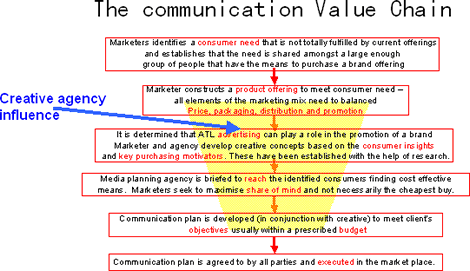
The Media Agency Sphere of Influence
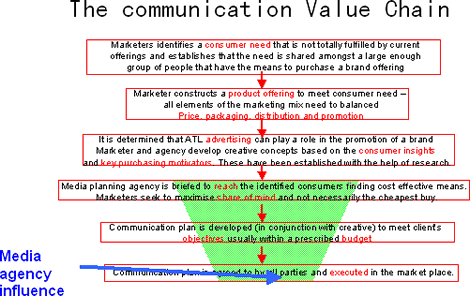
The Media Owner Sphere of Influence
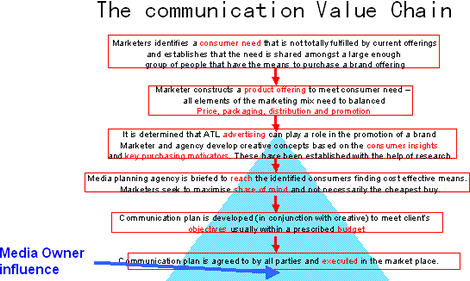
Return on Investment
Marketers require the communication function to provide a direct return on investment. Marketing budgets are often set as a percentage of the previous sales period's net sales or against the current period sales targets. This percentage can vary significantly, depending on the category, as well as current performance of the brand. That is why marketing and advertising budgets are the first to be slashed when brands/companies perform poorly. The expected return on advertising spend generally becomes shorter in tough economic times. Consumer off-take is required quickly or else the brand/communication content or target segments are changed or removed altogether. Marketers will focus on those segments which they anticipate will give them the greatest ( and often quickest) return.
Economic climate
The general economic outlook for the communications industry does not look good in the short to medium term. Communication spending is anticipated to be at best static and at worst, lower than the 2001 levels. In this climate marketers tend to focus their activity against primary targets, using fewer media channels, with the objective of maximising returns quickly. Secondary targets with anticipated longer-term returns, tend to fall by the way side.
"2002 looks to be a year media owners would rather forget", according to the latest Media Inflation Watch released by IBIS Media Data Services. The asking price for advertising space and time shows a 5.9% increase for the first six months of 2002 against the same period of 2001. This is the lowest in the 15 years of available data. For the first time ever it looks as though the full year will be lower than the Consumer Price Index, projected by Nedcor to be 9%.
Marketing and advertising investments are a barometer to the economic climate around the world. The USA is expected to take a decline in Above-the-Line advertising of 0.5% in 2002 according to Merrill Lynch July report.
Measurement
Communication output measured by Adex captures the majority of Above-the-line expenditure, but there is no measure of Below-the-line spending. Interestingly, global trends show that most companies are increasingly using non-traditional media vehicles to communicate with their target markets, be it consumers or business. According to current global figures we are possibly not capturing 50%-55% of communication investment.
However issues around targeting would still pertain to BTL. BTL channels are probably the most relevant to rural consumers due to the lack of access to ATL media types. We may find that this BTL spending directed against the lower LSM's, reveals a different picture on biased spending patterns.
Innovation
Innovation is a key to help retain consumers within a brand, by keeping abreast of consumers evolving needs and remaining top of mind. Compared to other developed nations, we have little product innovation originating in South Africa. Marketing companies tend to get involved in global rollouts. These generally focus on the added value/premium end of the product spectrum, and in turn influence communication spends. Marketers tend to generate greater profit margins as consumers are prepared to pay more for added value offerings. A marketer would have had to determine whether a sizable market exists for a particular innovation and whether consumers are prepared to pay more. This is usually done with the aid of research. Identifying these niche segments is influenced by the interpretation of the research results, and may therefore be perceived to be biased. However, marketers will always gravitate to where they expect a return on investment.
Consumer needs and wants
This is key to segmenting the market. Product consumption moves from basic intrinsic benefits to offering a lifestyle match. However there are a number of questions that marketers need to ask themselves once they have identified a consumer need;- does the target market have the means to buy the offering? Are there enough consumers who would share this need to create critical mass for a brand offering? How long will it take the brand offering to reach break even and become profitable? Can the company afford to investment this money? At the end of the day, a smart marketer would not be expected to make decisions that would not give their company a decent ROI. Through this process, the danger would be to let one's own personal views of the world influence the business decisions we make. It would make us the worst business people in the world if we let our prejudices limit the growth of our brands.
Segmenting the market
Segmentation tools assist in grouping together "like" people in order to make sense of a brand's relative potential in the market place. Many tools exist, and a combination of them should lead to a thorough understanding of the market. Most importantly, these tools should allow the user to access and measure changes in the identified segments over time.
We believe the basic segmentation tools and research available to the whole industry via AMPS are reflective of the basic demographics of society. AMPS should be used to highlight market trends that form the basis of the marketer's own research to establish the explanations for the current market landscape and purchasing patterns. Example of how the market can be segmented by LSM (using 3 information sources) is shown below.
Identifying the greatest volume potential
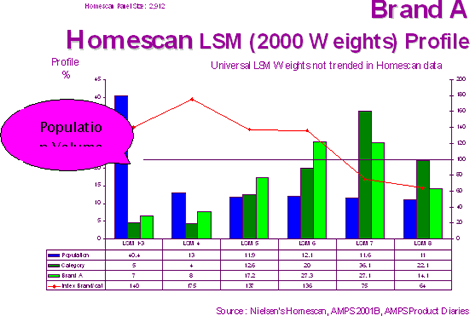
Comment: The graph above shows that consumption of brand A and the whole brand category does not necessarily follow the population spread, leading to some initial understanding of where the current volume potential is versus potential consumption. Interestingly, brand A is a premium brand that for a number of years was not well represented amongst LSM's 5 and 6. The marketer of brand A shifted focus over the past few years to LSM 5 and 6 and moved the upper LSM's communication to a maintenance strategy.
Different ways of segmenting the market
Geographic Segmentation
One of the earliest forms of segmentation was geographic. Smaller manufacturers with limited resources and channels of distribution focussed on the local area. Geographic segmentation is still in operation, especially for products that are costly to distribute over long distances and that can be readily manufactured in different regions. For example, beverages has strong regional skews in South Africa eg tea brands have different regional strengths. Most South African advertisers embark on national campaigns. Geographic segmentation is extensively used in the USA, where many regional brands and media opportunities exist.
Demographic segmentation
Demographic segmentation is extensively used, especially in defining media planning and buying targets. Products are frequently aimed at a particular age, gender or income group. Usually a combination of between 2 and 4 demographic criteria are used in target definitions. Demographics is commonly used in the media planning phase for the detailed selection of media vehicles eg for buying Television airtime.
Criticism against this segmentation includes the following: They are believed to be less effective predictors of purchasing behaviour, loyalty and price paid. Attitudes, beliefs and values are felt to be stronger predictors.
Volume Segmentation
Volume segmentation is conceptually appealing. If a small number of consumers are responsible for the bulk of consumption and purchase, then it should be more efficient to concentrate marketing efforts in their direction. For many product categories, only 20% of the buyers purchase 80 percent or more of the volume. A good example is the cellular market in South Africa where penetration of cellular telephony follows LSM's and there is disproportionately high use within certain LSM groups. If one looks at this it appears as if the cellular market is broadly spread across LSM 5-10. However it is the contract users (rather than pre-paid), that contribute most to volume and profit.
Profiles versus penetration

Comment: The contract market is skewed to LSM8-10. The prepaid market is broadly spread across LSM 5-10.
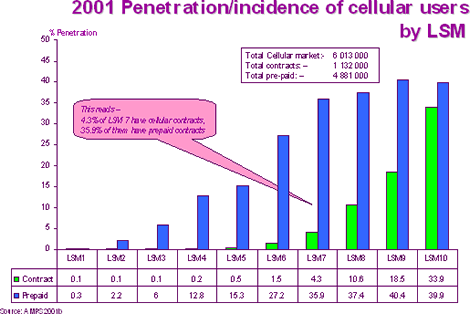
Comment: LSM 10 consumers are high users of both contract and prepaid airtime. There is a high incidence of prepaid usage from LSM6 upwards.
To grow Contract market - LSM 9 and possibly more people in LSM 10 would possibly give more volume opportunities. To grow the pre-paid, LSM's 5, 6,7 looks the most viable.
The cellular companies need to find the ideal balance between the two markets, i.e. the mass market of prepaid (possibly lighter users), and the smaller (heavy user) contract market? Cellular companies would possibly want to focus on heavy users (approx 20% of all users) who, in the short term, give more profit whilst investing against prepaid users (approx 80%) who may in time convert to contracts.
Further opportunities exist to use this approach to segmentation with the introduction of branded data as well as to fully utilize the available product data.
Brand Use
This approach will become available to South African advertisers by mid 2003 with the introduction of TGI branded survey and AMPS Branded data. Both surveys (which will be introduced on a user pay model), will allow interrogation of consumers to a specific brand as well as overlaying their media consumption habits. A far more accurate match of actual consumers to media opportunity will become possible.
Personality, lifestyle, interests, attitudes and opinion segmentation
Personality, lifestyle, interests, attitudes and opinions have also been used to segment markets. It has been found that these have some influence on buying behaviour. Categories that make use of this approach include haircare, and beauty products.
Greater success has been found with "self-concept" segmentation, an aspect of personality.
Self Concept Segmentation
Self-concept is formed through the interaction with other people, social institutions (like the church, schools, parents, teachers and friends). Products, and the way they are used, communicate meaning both to the individual and to others. Motor vehicles and other aspirational brands make use of this approach.
Benefit Segmentation
The benefits that consumers seek in products and brands have been used as the basis for market segmentation. There is an inherent logic in the classification of consumers into groups who share the need for similar bundles of benefits. Categories such as detergents would include this approach in their segmentation approach.
Value Segmentation
A major advantage of typological segmentation based on values is that it identifies groups of people in terms that are causal to behaviour, rather than descriptive. Both benefit and value segmentation have this in common. This is probably the most advanced type of segmentation approach requiring intensive research budgets.
Segmentation by Living Standards Measure (LSM)
The Universal LSMs
SAARF LSMT stands for 'Living Standards Measure'. In the late 80s, SAARF set out to devise an index using a combination of variables that would be stronger than any single variable in terms of differentiating and thus more useful to marketers. LSM's scales are used for indicating the socio-economic status of an individual or group. Globally, SAARF's LSM's are recognised as one of the most sophisticated segmentation models and are often given recognition at research symposiums.
In 2001 the LSM classification was further refined with the introduction of the Universal LSMs, which could be used consistently for all markets and, which did not need year-on-year adjustments.
The SAARF Universal LSMT scale is divided up into ten segments containing roughly equal numbers of people. Those with the lowest standard of living, as measured by LSMs form the segment referred to as 'SAARF LSMT 1', and those with the highest form 'SAARF LSMT 10'. The Universal SAARF LSMsT are based on 29 household variables, to give finer definition to the scale.
The 29 variables follow: -
| 1. Hot running water | 16. 0 or 1 radio set in household |
| 2. Fridge/freezer (combination) | 17. Hi-fi/music centre |
| 3. Microwave oven | 18. Rural rest (excl. W. Cape & Gauteng rural) |
| 4. Flush toilet in/outside house | 19. Built in kitchen sink |
| 5. No domestic in household | 20. Home security service |
| 6. VCR | 21. Deep freezer |
| 7. Vacuum cleaner/floor polisher | 22. Water |
| 8. No cell phone in household | 23. M-Net/DStv subscription |
| 9. Traditional hut | 24. Dishwasher |
| 10. Washing machine | 25. Electricity |
| 11. PC | 26. Sewing machine |
| 12. Electric stove | 27. Gauteng |
| 13. TV set | 28. Western Cape |
| 14. Tumble dryer | 29. Motor vehicle in household |
| 15. Home telephone |
Average Household income by LSM
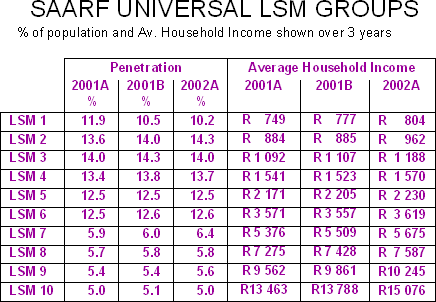
Adult Population broken down according to the Universal LSM's
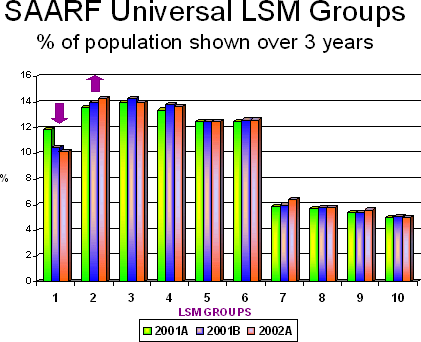
Comment: LSM's 2-6 are the larger LSM groups accounting for 67% of the population.
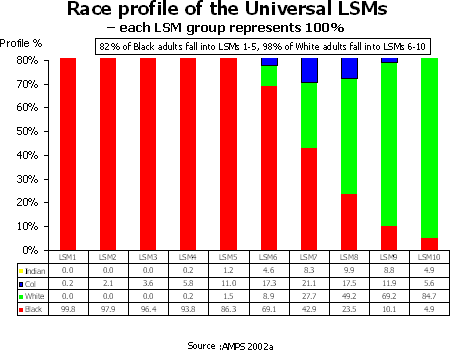
Race profile of the LSMS
Comments: LSMs 1-6 are dominated by Black adults, LSMs 8, 9 and 10 by Whites. There is no specific segment that includes all Black people or all white people. Black people are found across all the 10 LSM groups.
Our view on segmentation and specifically LSM's
We strongly suggest that users of segmentation tools should always stop and think when they interpret information. Use of historical analysis (and knowledge) to the exclusion of current changes in the market as well as ignorance will continuously lead to biased decision making to the disadvantage of the greater population of S.A.
We view the Living Standards Measure as a robust and statistically sound measure using the current variables available in AMPS. However perhaps more could be done to ensure the variables included in AMPS are fully reflective of the dynamic culture of our society and the varying "icons" of wealth eg traditional measures of wealth such as heads of cattle. The LSMs reflect historical income, but are not necessarily indicative of today's purchasing power and cannot be used to determine purchase intent for the future.
In light of the above mentioned factors it is imperative that the LSMs are not used in isolation and hence other demographics and social dimensions should also be considered in targeting exercises.
Although the statistical basis for the LSMs may be complex, it is certainly easy for the end user to access and use.
Race
-
Race is another demographic that is useful for understanding the complexities of markets as well as developmental trends. We congratulate SAARF on their decision to keep race in the AMPS survey. We believe that there is nothing inherently wrong with the race demographic. It has its place alongside all other demographic variables.
-
However, it is the use of the race demographic by marketers and agencies that should go under the spotlight. Historically, the liberal use of the words "Whites and Blacks" has led to stereotyping and generalizations that crept into marketing speak. We should eradicate this practice at all costs. The use of race in research or marketing is the exception not the rule, there are only a handful of brands that could claim to have a legitimate case for focusing on the race demographic (eg hair straighteners, skin lighteners etc). Race, (in targeting) is therefore not common practice. Elements such as aspiration, lifestyle etc are far more important in targeting and identifying the commonalities between individuals.
- The issue surrounding racism in communications goes a lot deeper than a single demographic variable, and encompasses peoples value systems, attitudes and behaviour etc
Final Thought on Segmentation
Finally, it must be stated that marketers and agencies often find their competitive edge in the way they interpret and use segmentation and research data. In light of this, there is an understandable reluctance to share "best practice principles" within the broader industry.
Possible breakdowns in the process
-
We know that the targeting process should be re-looked at least annually to reassess all market trends (e.g. electrification and telecommunication changes) and the investment by segment realigned based on the changing market potential. In reality this probably does not happen.
-
Budgets are often set as a % of net sales and not necessarily task driven. These budgets are "rolled" from year to year, and therefore tend to support the same types of activity.
-
A lack of professional and time resource can mean that markets are not "taken apart" and "rebuilt" regularly enough. In this climate, marketers and their agencies could potentially operate off historical knowledge and their personal experience of their markets as the basis of future strategies.
-
We, (all) possibly do not spend enough time in the trade and out in the market place. Once again pressures on resources mean that marketers, agency personnel and creative develop and keep up to date with the markets largely from behind their desks. Media people do not meet up with editors and station managers to fully understand the multiplicity of media products (several hundred) available, particularly those that fall outside their immediate geographic location. Everyone acknowledges that this is not ideal, but it is a reality and a consequence of economic and time pressures.
-
Training and mentoring is sometimes lacking. Young people (particularly media planners) are not guided sufficiently in their interrogation of markets and in the development of communication strategies.
-
Some clients are trying to save costs by paying agencies less, thus crippling agencies own transformation endeavors.
- Clients often demand measurability and accountability whilst also insisting on innovation and originality, which means we dance to two tunes simultaneously. The over-riding strategy is one of risk aversion. The new/developmental media often suffer.
Moving forward
-
Let us not forget that it is the pursuit of new business opportunities and incremental volumes that grow companies and profits. Marketers would be negligent to ignore potential new markets and growth opportunities. However, it would be foolhardy to target brands broadly to segments that are not relevant to one's brand.
-
Clients responsibility
-
It is the responsibility of marketers to drive the transformation process within their organisations and demand it of their agencies. We have to start at the top of the value chain, with the most influential player and holders of the purse string, if are to be effective in transformation.
-
It is the responsibility of marketers to drive the transformation process within their organisations and demand it of their agencies. We have to start at the top of the value chain, with the most influential player and holders of the purse string, if are to be effective in transformation.
-
The entire Value Chains' responsibility
- We believe it is senior management's (CEO's, MD's, Marketing Directors) responsibility, both at a client and agency level, to institute sound and professional processes in the development of marketing and communication strategies.
- It is their responsibility to ensure that new recruits are trained and equipped to understand and operate in our multi-dimensional market and diverse society.
- It is also incumbent on senior management to ensure that all elements of the communication effort are in-line with the corporate strategy both in terms of the media vehicles utilized and the communication content.
- Senior management need to develop and ensure that ongoing immersion programmes take place amongst all personnel involved in the communication development i.e. within agencies and client organisations.
- Such immersion programs could entail interacting with consumers of different ethnic groups, urban to rural, formal and informal settlements; visits to media owners and understanding their offerings and consumer interface; assisting creative personnel to understand the changing South African landscape and consumer diversity.
- Clients and agencies need to ensure that their suppliers particularly research houses; packaging and promotional companies etc adopt the same approach to "immersing" their key staff.
-
Senior management needs to commit their companies to become representative organisations and specifically to bring qualified Black people into middle and top management positions. Active retention programs need to be implemented.
-
Media Owners responsibility
-
Responsibility also lies with media owners to "up their game plan". Something must be sold before it is bought. Media owners operate in extremely competitive environments and as such professional service, innovation and selling can directly improve advertising revenue.
-
Responsibility also lies with media owners to "up their game plan". Something must be sold before it is bought. Media owners operate in extremely competitive environments and as such professional service, innovation and selling can directly improve advertising revenue.
-
Education
-
Inclusion of marketing segmentation approaches in the curriculum of tertiary institutions.
-
Inclusion of marketing segmentation approaches in the curriculum of tertiary institutions.
-
Research
- More SAARF training. All people involved in the communication process need to be exposed to the SAARF products, trends, modifications etc at least annually so they do not operate with out-dated knowledge. The SAARF training should focus more on trending data highlighting key developments in society.
- The understanding of the market from this valuable source of data is not the sole responsibility of the media planner. Clients and agency personnel should undertake their own interrogation
- SAARF and its stakeholders need to strive to continually refine and improve the common targeting tools available. In light of this we support the drive to accessing branded data and providing for the market the opportunity to plan specifically against a particular brand's usership base. A shift in focus to common communities as opposed to differences.
- Product category data should be made available for planning purposes across all media including television.
- The introduction of branded data in 2003 to the South African market should help remove much of the interpretation required to develop a specific brand plan as media can be matched directly with the consumers of the same brand. Not all advertisers will be able to afford this research as it is sold on a user pay basis.
- We support SAARF's exploration of enhancing the SAARF data with behavioural lifestyle questions. In the years to come, assuming financing is available this may even be extended to include attitudinal, a "day in the life of", and spending pattern information.
-
Concurrent to the recommendations above, we suggest that as new media come into the market, they receive assistance by the relevant industry bodies to guide them in marketing themselves and possibly draw on the experience of successful commercial media business. New media must also be brought into the (SAARF) research frame as early as possible.
- Brenda Wortley and Maserame Tshwaedi

